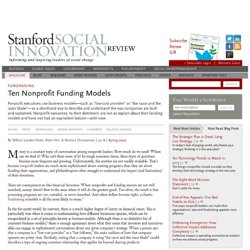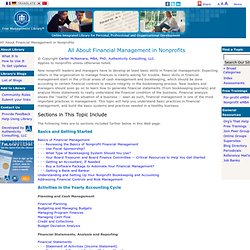

Article - Costs are Cool: The Strategic Value of Economic Clarity. Download PDF Author(s): Susan J.

Colby, Abigail M. Rubin Published Date: December 01, 2003 For most nonprofit organizations, the art of making tradeoffs is a condition of survival as well as a key element of success. Given this fact, the scope of the financial data available in many nonprofits is worrisome. Several factors contribute to the dearth of good financial information in nonprofit organizations. Economic Clarity Informs Critical Resource-Allocation Decisions To make resource-related decisions intelligently, that is, in a way that maximizes an organization’s impact and promotes its mission, nonprofit leaders need to have a clear picture of the full costs of operating their programs and services.
By complementing a strong sense of mission with a strong understanding of their organization’s operating costs, nonprofit decision makers can equip themselves to make the right allocation choices. Which programs do we fund? Ten Nonprofit Funding Models (March 16, 2009) For-profit executives use business models—such as "low-cost provider" or "the razor and the razor blade"—as a shorthand way to describe and understand the way companies are built and sustained.

Nonprofit executives, to their detriment, are not as explicit about their funding models and have not had an equivalent lexicon—until now. M oney is a constant topic of conversation among nonprofit leaders: How much do we need? Where can we find it? Why isn’t there more of it? In tough economic times, these types of questions become more frequent and pressing. There are consequences to this financial fuzziness. In the for-profit world, by contrast, there is a much higher degree of clarity on financial issues. The value of such shorthand is that it allows business leaders to articulate quickly and clearly how they will succeed in the marketplace, and it allows investors to quiz executives more easily about how they intend to make money.
Duke University business professor J. All About Financial Management in Nonprofits. © Copyright Carter McNamara, MBA, PhD, Authenticity Consulting, LLC.

Applies to nonprofits unless otherwise noted. New nonprofit leaders and managers have to develop at least basic skills in financial management. Expecting others in the organization to manage finances is clearly asking for trouble. Basic skills in financial management start in the critical areas of cash management and bookkeeping, which should be done according to certain financial controls to ensure integrity in the bookkeeping process. New leaders and managers should soon go on to learn how to generate financial statements (from bookkeeping journals) and analyze those statements to really understand the financial condition of the business. Sections in This Topic Include. Not for Profit Organizations. NPO's should be concerned about compliance including GST/HST, payroll and income tax reporting.

NPO's are required by law to keep proper books and records. Let me help with how to keep records. Click here: Mastering QuickBooks® software for 20 hours of video training on how to set up a proper set of books and records. The cost of training staff and finding affordable training each time there is staff turnover is challenging for non profit organizations. Funding for administration and training is hard to find. Disclaimer: Eileen Reppenhagen CGA does not research or endorse any product or service appearing in ads posted on this site.
All Intuit®, QuickBooks® Software,Quicken® Software and Profile® Software trademarks remain the property of their respective holders, and are used only to describe the products discussed on this website.. Build a Nonprofit Financing Plan. “I wanted to say thanks for the guide… it’s exactly what we needed.

It’s an excellent template for sorting through the future financing for the organization.” – Guide User A financing plan, unlike a traditional fundraising plan, is an integrated, thoughtful, and strategic way to help a nonprofit raise enough money to achieve its programmatic and organizational goals. Instead of asking the question: “How much can we accomplish with what we can raise?” In building a Financing Plan you are asking the question: “How much should we raise to accomplish our goals?” A Financing Plan is a long-term strategy for bringing enough money in the door to achieve your mission, ultimately bringing you closer to achieving your mission and creating change in your community.
This guide will walk you, step-by-step, through building your nonprofit’s Financing Plan. The sections of this guide are: 1. 2. 3. 4. 5. Nonprofit Bookkeeping Test. If you're not an accountant yourself, it can be hard to hire a qualified bookkeeper.

How can you tell if an applicant really knows bookkeeping? CPA Dennis Walsh created this terrific assessment test you can give candidates for bookkeeping and accounting jobs. We especially like the chart at the end that shows what training is called for based on which questions were answered correctly or incorrectly: This 21-question quiz samples from general bookkeeping knowledge as well as nonprofit bookkeeping and compliance matters. Use this assessment test as part of your hiring toolkit as well as for identifying staff training needs.
The Nonprofit Bookkeeping Assessment Test We recommend that you give an applicant 20 minutes to complete the assessment test. 1. Reading Nonprofit Financial Statements: How to Be a Financial Detective.